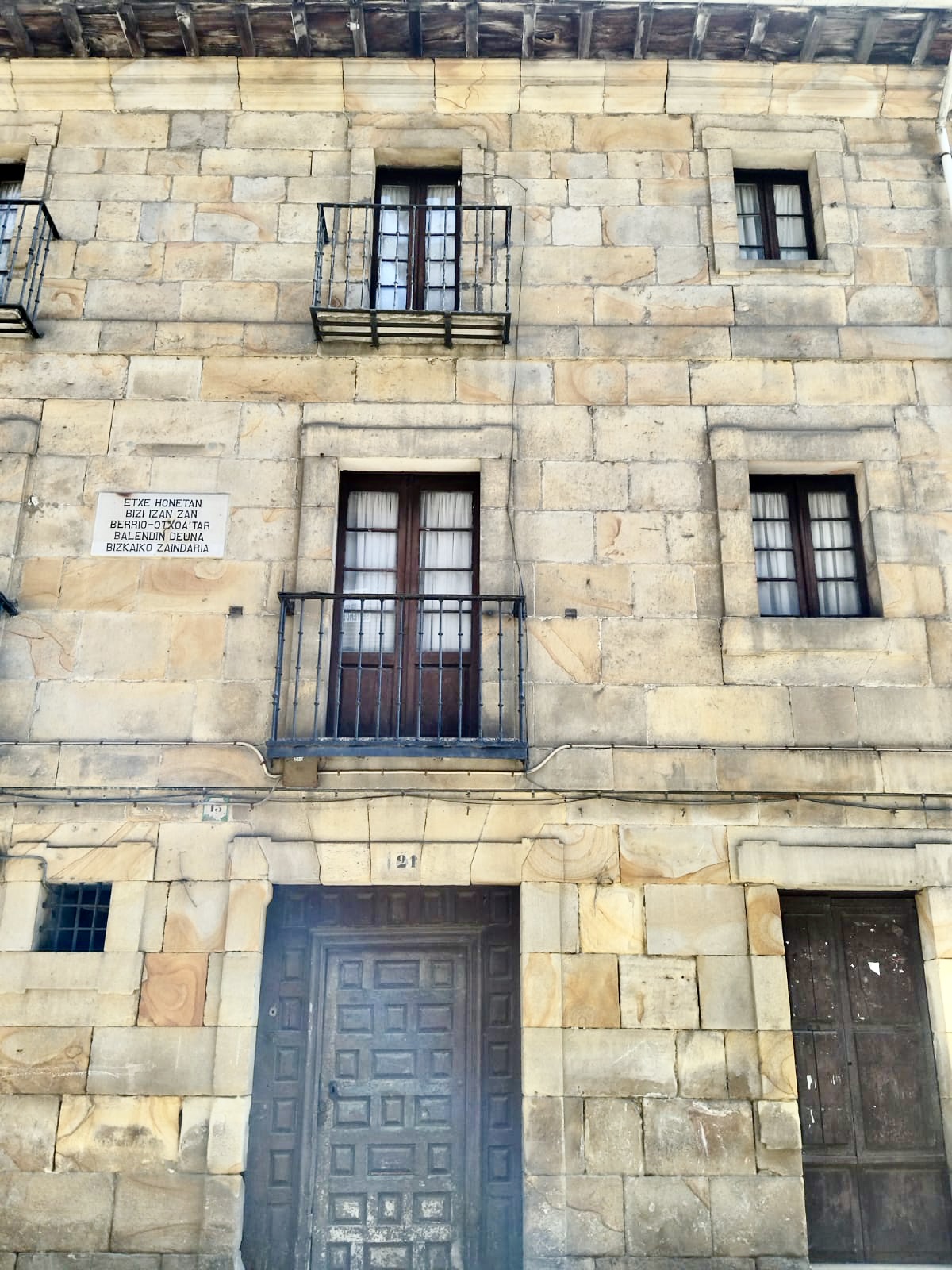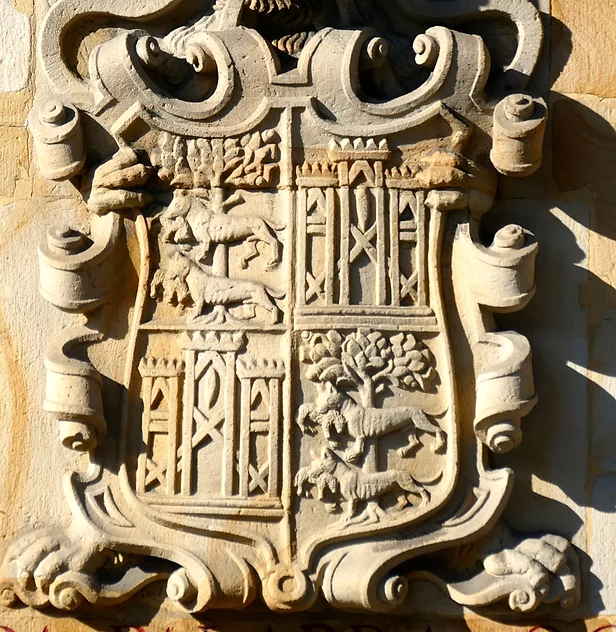San Valentín de
Berrio-Otxoa Trail
SAN VALENTÍN DE BERRIO-OTXOA TRAIL
On this walk, you will travel with Elorrio’s most famous resident. You will go all the way to Vietnam and the Philippines in an exciting 6-stop trail. Happy travels around the world!

1. . ARRIOLA MANSION – BIRTHPLACE
Valentín de Berrio-Otxoa was born in Arriola mansion on 14th February 1827. He was baptised Valentín Faustino de Berrio Otxoa y Aristi in his parish church.
The Arriola mansion was built in the Baroque style by Juan Otxoa de Arriola at the beginning of the 17th century. It includes an interesting wrought iron railing on a beautiful overhanging balcony, displaying the family’s coat of arms.
On the balcony of the first floor, we can read the inscription: “Valentín de Berrio-Otxoa was born in this house on 14th February 1827″. The simple design and high quality of the construction are the most representative features of this house.

ROUTE DESCRIPTION
- Difficulty: Easy
- Walk type: Religious
- Duration: 120min

BERRIO-OTXOA MUSEUM
- Address: Elizburu 4 – 48230 ELORRIO
- Telephone: +34 946 82 04 55 – +34 669378097
- Guided tours: reservations in advance by phone
- Free entrance

2. HOME
Berrio-Otxoa lived in this house with his father Juan Isidro Berrio-Otxoa (Elorrio, 1801) and his mother María Mónica Arizti (Antzuola, 1797). It was a family of humble means, devoted to carpentry.
At the age of 18, he joined the seminary in Logroño, but not long after he was forced to abandon his studies and return to Elorrio in order to attend to his family’s financial needs. With the help of his friends, he was able to return to the seminary, and in 1851 he was ordained as a priest. He was sent to Asia as a missionary, visiting the Philippines first and then Vietnam.
At that time, King Tu-Duc of Vietnam severely persecuted the missionaries who lived in hiding in caves and cabins, believing that they were collaborating with European governments in their attempts to occupy and colonise his kingdom.




3. BASILICA OF THE INMACULATE CONCEPTION
The basilica of Elorrio is considered the greatest in Bizkaia, not only because of its size, but also because of the quality of its construction, and the magnificent furnishings within. Work for this 29-metre-tall architectural wonder began in 1464, in the late Gothic style, and it took over two centuries to complete. Its magnificent bell tower is a replica of the Giralda of Seville, and was built thanks to the devotion of the people of Elorrio. But let us continue our journey.
The mausoleum altar
It is worth taking a closer look at all the detail on this altar, built in 1906 upon the beatification of Berrio-Otxoa, our story’s protagonist. As you can see, the style is completely different from the rest of the basilica’s furniture: the altar is more modern, and of Asian inspiration. The mosaic on the altar portrays the missionary’s death, showing the small cage where he was imprisoned, too small for him to stand up. He was killed in Vietnam, along with other missionaries, for refusing to renounce his faith.
On 7th June 1886, his body arrived in Barcelona, where many Bizkaians awaited him. Sabino de Arana, who was also present, had this inscription placed there: “Berrio Otxoa Barzelona’ko Euzkaldunak. 1886’garren urtean Bagillan”. (“Berrio-Otxoa. The Basques of Barcelona. In July in the year 1886”). From there, his body was sent to Elorrio, and received in a celebration attended by representatives from all around Bizkaia. To this day, his remains are in the central urn of the altar.
At the back of the building there is a monolith in honour of Berrio-Otxoa, designed by Matilde Roca de Togores and made in bronze by José Luis Valenciaga. It was installed in 1988 in celebration of the canonisation of Berrio-Otxoa, following the development of the area behind the basilica.


4. CONVENT OF SANTA ANA
From the ages of ten to fifteen, Berrio-Otxoa was an altar boy in the nunnery of Santa Ana.
This group of buildings, built in 1699, originally consisted of a church, a convent, grammar and Latin classrooms (where Berrio-Otxoa studied), and living quarters for the chaplains. Today, the ground floor of the convent is home to the Berrio-Otxoa Museum.
The convent is currently inhabited by cloistered Dominican sisters, who specialise in sweet treats. Their “mostachones” are not to be missed. If you ring the doorbell hanging from the ceiling, they will answer by saying “Ave María Purísima” (“Hail Purest Mary”) to which you would usually reply “Sin pecado concebida” (“conceived without sin”).
They will be delighted if you take away some of their hand-baked delicacies with you. Aside from their mostachones, they have also been baking all kinds of cakes for the past 30 years.
Take a look at the sculpture in front of the convent. It is San Valentín de Berrio-Otxoa himself. It was sculpted by Alberto Foraster in 1991, in memory of Berrio-Otxoa’s canonisation in 1988.

5. BERRIO-OTXOA MUSEUM
The museum devoted to the figure of San Valentín de Berrio-Otxoa, opened in 2003, is located in the convent itself. Through objects and documents, it covers the saint’s early years in Elorrio, his learning period in the seminary of Logroño, his missionary life and the processes of beatification and canonisation after his martyrdom.
The exhibition includes documents, photographs, maps, autograph texts, paintings, and pieces of goldsmithing and textiles, as well as various objects pertaining to the life and work of Saint Valentine of Berrio-Otxoa.

6. THE FRONTON
Although he was a skilled dancer, young Valentín’s favourite sport was Basque pelota, known as eskupilota in Basque.
Like most children of the time, he played at the old pelota court (or “fronton”) in Elorrio, where you can still see three beautiful arches, which are not part of the old wall, contrary to what one may think.
The new fronton was built in 1933. Three men who were born around that year and who lived in Errekakale Street, Hilario Azkarate, Felipe Lejarazu and José Antonio Álvarez, were champions in different pelota leagues and categories: a testament to Elorrio’s love for this traditional Basque sport.

Extended information...
San Valentín Berrio-Otxoa
Biography
Source: Eusko Ikaskuntza
Basilica of Elorrio
More information
You may also like...
CALVARY WALK
Discover Elorrio’s history by following these monumental crosses.

THE BASILICA
Meet the Immaculate Conception of Elorrio


NECROPOLIS OF ARGIÑETA
The most important medieval funerary complex in the Basque Country

HERALDRY TOUR
A tour covering the coats of arms of Elorrio and their history.


WINTER OPENING HOURS
From 15th September to 31st May
Monday: closed
Tuesday to Friday: 10:00 - 14:00
Saturday and festivities:
10:00 - 14:00 and 16:00 - 18:00
Sunday: 10:00 - 14:00
TOURISM OFFICE
Berrio-Otxoa Street, 1
48230 Elorrio (Bizkaia)
CONTACT US
SOCIAL MEDIA




